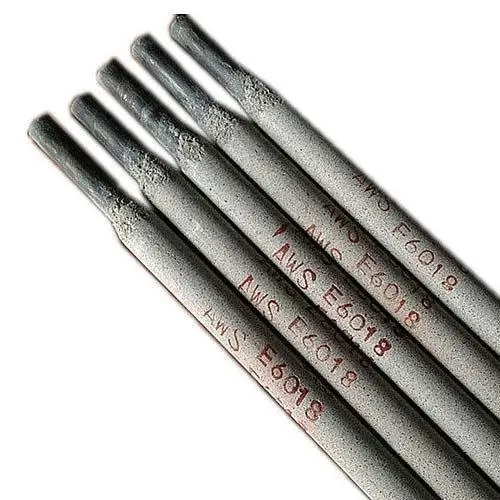The E8018 welding rod is a low hydrogen electrode commonly used in high-strength, low alloy steels. Its outstanding tensile strength, low temperature compatibility, and versatility in various welding positions make it suitable for many demanding applications.
Table of Contents
Properties of E8018 Welding Rods
| Property | Detail |
|---|---|
| Type of Electrode | Low Hydrogen |
| Tensile Strength | High |
| Service Temperature | Low |
| Weld Metal Composition | Low Alloy Steel, Iron Powder, Nickel |
| Welding Positions | All |
| Coating Type | Iron Powder Low Hydrogen |
| Current Type | AC, DC+ |

Common Uses of 8018 Welding Rods
When I was just getting started as a welder, the E8018 welding rod was a reliable companion in various applications. Over the years, I’ve come to appreciate its strength and adaptability even more. Its alloy content makes it highly useful in welding low alloy, high strength steels, often used in manufacturing critical components like pressure vessels, heavy equipment, and high-tensile pipes.
One of my most satisfying projects involved refurbishing a 1960s era steam boiler. The E8018 welding rod was my go-to for the job. Its properties shone through, providing a solid, long-lasting weld that met the boiler’s high temperatures and pressures. I can’t overstate the importance of picking the right rod for the right job!
Suitable Positions
The E8018 welding rod can be used in all positions. I’ve used it everywhere from flat to horizontal, vertical, and even overhead welding. It’s been my trusty ally when tackling complex tasks requiring out-of-position welding.
- Flat Position (1G): This is the easiest position to weld in. The E8018 excels here, allowing for smooth and straightforward passes.
- Horizontal Position (2G): When welding horizontally, gravity can be a bit tricky to handle. However, the slag viscosity of the E8018 rod is just right for holding the molten weld pool in place, making the job easier.
- Vertical Position (3G): Vertical welding usually involves moving the rod up or down the joint. It’s more challenging, but the E8018 provides a stable arc that helps maintain control over the weld pool.
- Overhead Position (4G): The most difficult position is overhead welding, where gravity works against you. The E8018, with its controlled and stable arc, helps keep the molten metal from dropping onto the welding surface or, worse, you!
Coating Type
The coating of a welding rod plays an essential role in the welding process. The E8018 welding rod comes with an iron powder low hydrogen coating. This type of coating has numerous benefits, and I’ve come to appreciate them over the years.
Firstly, the iron powder increases the deposition rate. This means you can lay down more weld metal faster, saving precious time on a big project.
Secondly, low hydrogen is critical for preventing hydrogen-induced cracking, a common issue when welding high-strength steels. By controlling hydrogen levels in the weld, this coating ensures a safer and more reliable weld.
Lastly, this coating type gives you a smooth and steady arc, which is a blessing, especially when working in difficult positions or welding thicker materials.
Welding Current
The welding current you choose can significantly impact the quality of your welds. The E8018 welding rod works effectively with alternating current (AC) and direct current electrode positive (DC+).
DC+ is my preferred choice in most cases. The steady current makes the arc more stable, ensuring deep and consistent penetration into the base metal. It gives you better control over the welding process, resulting in high-quality welds.
However, AC is also useful in certain situations. For instance, when dealing with magnetic materials, using AC helps prevent arc blow, a disturbance of the arc due to magnetic fields. I’ve found that switching to AC in these scenarios can give a more stable and cleaner welding experience.
Tips for Using 8018 Welding Rods
Using the E8018 welding rod effectively involves a few critical steps. Always keep these rods dry. Since they are low hydrogen electrodes, exposure to moisture can cause hydrogen-induced cracking. I’ve found it helpful to bake the rods at 375°F (190°C) for at least an hour before use.
And don’t rush. Take your time to set up correctly. Positioning and angle are key factors in creating a good weld. A steady hand and a clear mind will reward you with a sturdy and neat result.
Conclusion
The E8018 welding rod, with its distinctive low hydrogen, iron powder coating and high tensile strength, is an incredibly versatile tool in the world of welding. Whether dealing with low alloy steels or working in various positions, this welding rod delivers excellent results.
Remember to keep them dry, take your time, and choose the right current for your job. With these tips, you’ll get the most out of your E8018 welding rod.


